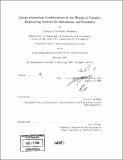Graph-theoretical consideration in the design of complex engineering systems for robustness and scalability
Author(s)
Bounova, Gergana Assenova, 1980-
DownloadFull printable version (22.14Mb)
Other Contributors
Massachusetts Institute of Technology. Dept. of Aeronautics and Astronautics.
Advisor
Olivier L. de Weck.
Terms of use
Metadata
Show full item recordAbstract
(cont.) and (2) a forward approach which achieves optimality at the start and grows the system using an optimization technique. We systematically compare the two staging techniques in the context of telescope arrays and evaluate the hypothesis that the backward approach is superior for telescope arrays because it incorporates knowledge of the desired future end state of the system. The modelling framework introduced is applicable to various engineering problems susceptible to network representation, including biological systems, telecommunication networks, transportation routes, and space exploration systems. System optimization for extensibility and robustness is a fundamental challenge of engineering disciplines. Traditional approaches have aimed to optimize cost and performance of a system at a given point in its lifespan. However, as systems evolve with increasing resources and load, system extensibility has to be included in the earliest stages of planning and deployment. In this thesis, we study the staged deployment of large telescope array configurations as an optimization problem subject to cost, performance and network robustness. The LOFAR (LOw Frequency ARray) is the world's largest telescope array, deploying in its full design 25000 antennas over 350kin in diameter in Northern Europe. These are deployed in clusters, and planned to be built in stages, with current funding allowing for 15000 arrays over 100km. This new generation of telescope arrays requires new system design principles and modelling techniques. We develop a staged optimization framework for modelling network behavior, robustness, and extensibility. We represent large telescope arrays as generalized networks, with nodes as the telescope stations and edges as the cable links between them. We model network design and growth with both graph-theoretical and physical metrics pertaining to imaging properties of each array configuration. Additionally, we model the probability of failure of each topology, both from environmental conditions and random events along the baseline. We make recommendations about the best cost-performance and robustness trade-off configurations. We introduce two staging principles for system deployment and configuration: (1) a backward approach, in which the design is optimized in the future and scaled down for the initial stages,
Description
Thesis (S.M.)--Massachusetts Institute of Technology, Dept. of Aeronautics and Astronautics, 2005. Includes bibliographical references (p. 113-114).
Date issued
2005Department
Massachusetts Institute of Technology. Department of Aeronautics and AstronauticsPublisher
Massachusetts Institute of Technology
Keywords
Aeronautics and Astronautics.